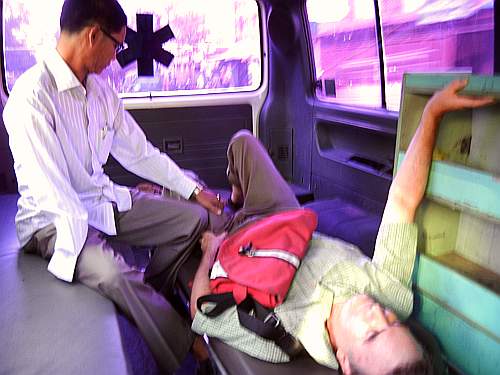 |
Selwyn was hit at the intersection of St. 63 and St. 310 when a motorcycle, not wanting to wait for the stopped traffic, went into the opposite lane, against the traffic, and ran into Selwyn on his bicycle. Fortunately his helmet protected his head which hit the ground first. Here he has just been placed in an ambulance (he was hit in front of a local clinic) with Youkhim, the director of AVI in Cambodia. |
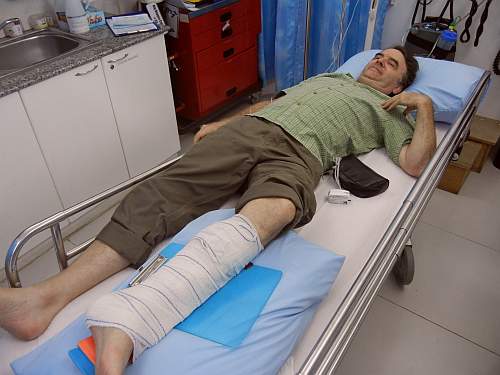 |
The local clinic was not the place to treat Selwyn so he was taken to S.O.S. International, the 911 service of Cambodia, where he was examined. X-rays showed that he had multiple fractures of both bones of his lower left leg and the S.O.S. doctors said he would have to be taken to Bangkok for surgery. Some of the fracture were compound, i.e., the bone coming through the skin, so his leg was cleaned and bandaged. Here the painkillers have started to take effect. |
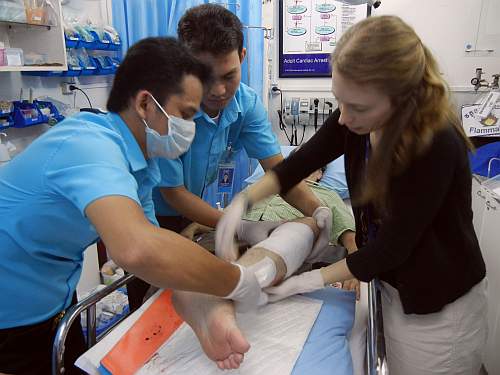 |
Dr. Claire and some of the S.O.S. staff then applied a temporary cast to the leg to stabilize it for the trip to Bangkok 300 miles away. Because he was in such pain and the cast required so much movement of his leg, he was sedated for this procedure. Notice his foot is at more than a 90-degree differential from his knee because it is no longer connected by bones to the rest of his leg. |
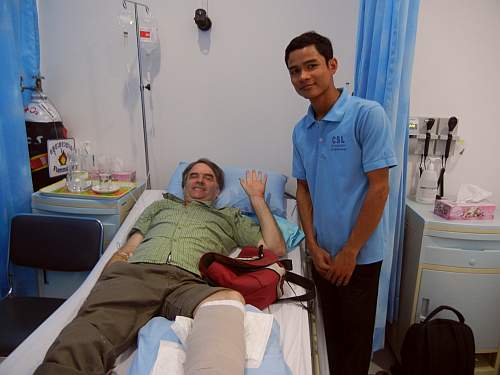 |
After waking, with the pain reduced and the cast ready to travel, Selwyn is able to manage a smile. With him is Tuenn, one of the DDP sign language interpreters who worked with Charlie with sign language in the nine hours between when Selwyn arrived at S.O.S. and his air ambulance took off for Bangkok. |
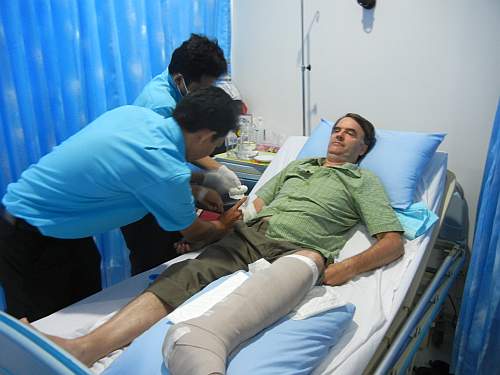 |
To further prepare Selwyn for travel, he was disconnected from the IVs, but the needle was left in his arm for further doses of painkillers during the flight. Here the S.O.S. staff cover the needle with bandaging. | .
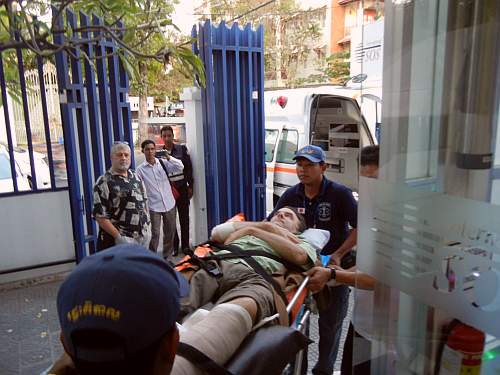 |
S.O.S. International does not have a purpose-built medical facility so Selwyn had to be wheeled out the front door on a gurney provided by the second ambulance service. |
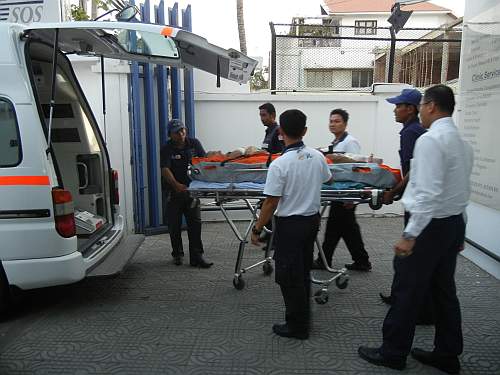 |
Here Selwyn is loaded into the second of the three four-wheeled ambulances he would use this day. This crew was quite professional by Cambodian standards which is probably why S.O.S. uses them. The driver used flashing lights and the siren but that had little effect on Phnom Penh traffic so he, too, just drove in the opposite lanes, against oncoming traffic, even on a divided street. |
 |
At the Pochentong Airport in Phnom Penh, the ambulance went around to the back side of the terminal where an air ambulance was waiting. One S.O.S. staffer then ran inside with the passports for Selwyn and me and all the Thai medical crew who had gone to receive Selwyn at S.O.S. so we wouldn't have to go inside for the normal immigration queues. |
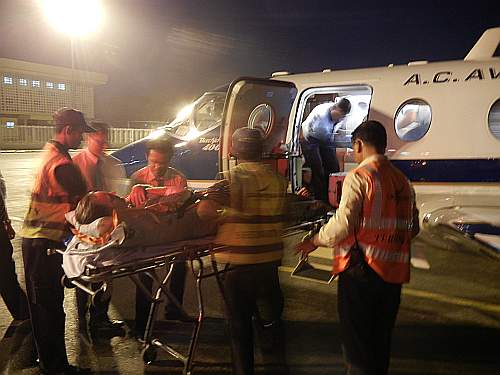 |
Finally all the formalities were completed and Selwyn was loaded into the Beechcraft business jet. It has eight seats, three of which were removed to accommodate the stretcher. There was a flight crew of two, a medical crew of four, and Selwyn and I. |
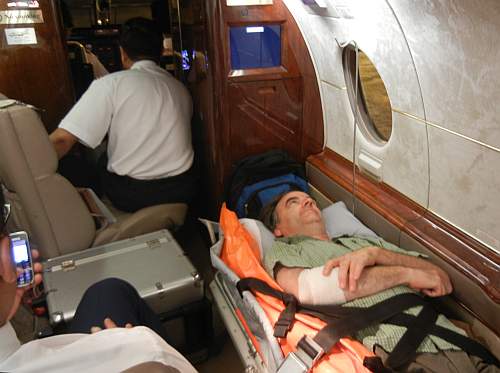 |
Inside the Beechjet 400A, the stretcher was placed forward along the starboard bulkhead to make it easier to get it in and out. These jets are not designed to load bulky things like stretchers. |
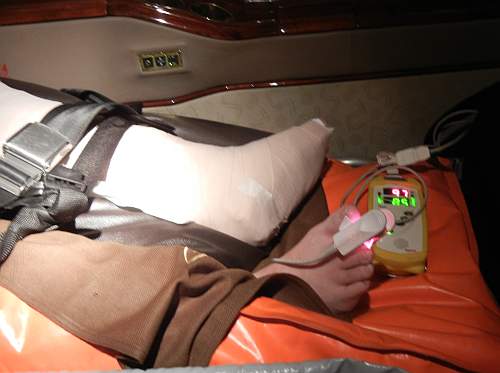 |
The 300-mile flight from Phnom Penh to Bangkok took a little over an hour. Both the flight crew and medical crew were really friendly professionals. On the way the doctor checked Selwyn's vital signs via his foot. |
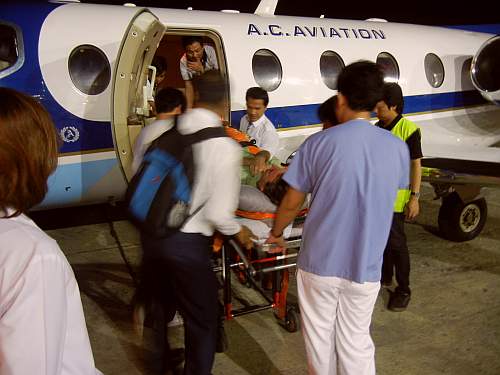 |
We landed at Bangkok's old airport and were met by another ambulance crew, this one from Bumrungrad Hospital. Each ambulance crew we met had more equipment, skilled personnel, and professionalism than the one before. |
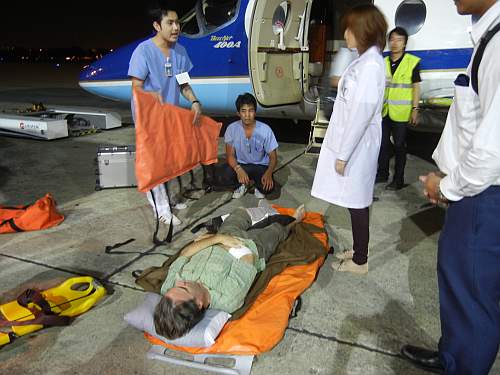 |
The woman in the white coat is a Bumrungrad Hospital doctor in charge of tonight's evacuation and she moved Selwyn first to the tarmac to give room to properly secure and stabilize his body and leg for the drive into Bangkok. They used really interesting soft stretchers and then an inflatable splint on his leg. |
 |
Finally we arrived at Bumrungrad Hospital's emergency room and more testing started. It was then 8:45 PM. An orthopedic surgeon, Dr. Winyou, had been alerted and came to ER himself to remove the cast there and assess the situation. His decision was to send Selwyn for a CT scan, then x-rays, and then on to the operating theater where the surgery started at 11:00 PM. They were expecting a three-hour operation but called me at 1:30 AM to say they had successfully completed it, and Selwyn was in the room at 2:30 AM, surprisingly awake and alert but soon fast sleep. |
|
Go to Part 2 |













